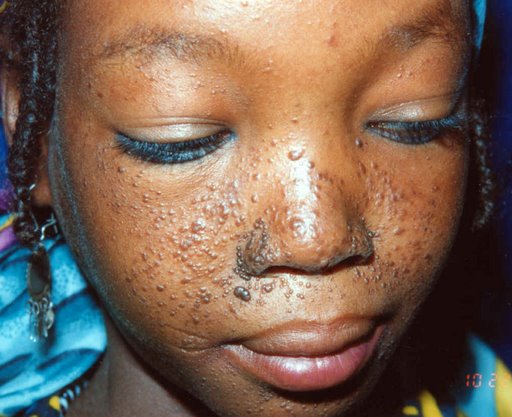MRCP2-0909
A 68-year-old woman presents with erythematous, rough lesions on the back of her hands. After diagnosis, it is determined that she has actinic keratoses. What is the best course of action for management?
A 68-year-old woman presents with erythematous, rough lesions on the back of her hands. After diagnosis, it is determined that she has actinic keratoses. What is the best course of action for management?
An 83-year-old man visits the dermatology clinic with scalp changes. He is bald and has noticed thickened and abnormal skin. He has a history of sun exposure from living in Spain for five years but has now returned to the UK permanently. He also has a history of smoking, but quit 15 years ago, and has quit drinking. He has been diagnosed with COPD, fractured NOF, gout, and hypertension. He regularly uses ipratropium, seretide, allopurinol, ramipril, amlodipine, and alendronic acid.
During the examination, the scalp appears erythematous with thickened plaques. It is mildly tender and slightly irritated. What is the most suitable treatment?
The following patient is undergoing treatment for epilepsy:

What is the probable underlying diagnosis for this case?
A 32-year-old man comes to the clinic complaining of a rash on his foot. He reports that he first noticed it four weeks after returning from Thailand. The rash is extremely itchy and has been causing him sleepless nights. He has no medical history and does not take any medications regularly. During the examination, a serpiginous track with erythema and oedema is observed on the superior aspect of his right foot.
What is the preferred treatment for this ailment?
A 78-year-old female presents to the hospital after experiencing a seizure where she lost consciousness and had twitching in all four limbs. She has a history of a previous stroke resulting in mild right-sided weakness and is also a type 2 diabetic. The patient is diagnosed with her first generalized seizure and is prescribed lamotrigine. During her hospital stay, she develops a sore throat and the following day, the healthcare provider notices peeling skin on her lower lip and a new well-defined red rash on her trunk. What is the most likely diagnosis?
A 42-year-old woman presents to the Rheumatology Clinic for evaluation. She has been diagnosed with rheumatoid arthritis and has been on various treatments, including methotrexate and biologic agents, but has not experienced significant improvement in her symptoms. She reports joint pain and stiffness, particularly in her hands and feet, which is affecting her ability to work as a hairdresser.
On examination, there is evidence of synovitis in multiple joints, including the wrists, metacarpophalangeal joints, and ankles. Laboratory investigations reveal the following:
Investigations Results Normal Values
Haemoglobin (Hb) 129 g/l 120–160 g/l
White cell count (WCC) 7.8 × 109/l 4.0–11.0 × 109/l
Platelets (PLT) 240 × 109/l 150–400 × 109/l
Sodium (Na+) 139 mmol/l 135–145 mmol/l
Potassium (K+) 4.1 mmol/l 3.5–5.0 mmol/l
Creatinine (Cr) 90 µmol/l 50–120 µmol/l
Alanine aminotransferase (ALT) 42 IU/l 5–30 IU/l
Alkaline phosphatase (ALP) 80 IU/l 30–130 IU/l
Bilirubin 10 µmol/l 2–17 µmol/l
Erythrocyte sedimentation rate (ESR) 45 mm/hour 1–20 mm/hour
What is the most appropriate next step in management for this patient?
A 67-year-old woman presents to the cardiology clinic after being admitted for a NSTEMI. During her hospital stay, an echocardiogram revealed mild-moderate LV systolic dysfunction with an ejection fraction of 40%. She reports feeling well since discharge, but experiences mild breathlessness when climbing two flights of stairs. During the examination, the physician notices a rash on her lower legs consisting of tense blisters and minimal underlying edema. Which medication is most likely responsible for the rash?
A 30-year-old woman presents to the ED with a sudden onset rash. She reports feeling fatigued lately with a sore throat and cough. She is a smoker of 10 cigarettes/day.
During the examination, the patient has multiple painful erosions on the inside of her lips, an inflamed throat, and diffuse wheezing. On her palms and forearms, she has several swollen papules, some of which have small blisters in the center, forming a target-like lesion.
What is the most probable trigger for her condition?
A 35 year old male of Arabic descent with bullous pemphigus is admitted for intravenous immunoglobulins. He has no significant medical history, has not traveled recently, and has lived in rural Norfolk his entire life. On the fourth day of treatment, he experiences fever, nausea, and vomiting. Upon examination, mild neck stiffness and photophobia are noted, and he complains of a headache in the back of his head. The following serum markers are present:
– WBC: 14.5 * 109/l
– Neuts: 11.2 * 109/l
– Na+: 134 mmol/l
– K+: 3.9 mmol/l
– Urea: 4.8 mmol/l
– Creatinine: 82 µmol/l
– CRP: 5 mg/l
A CT scan of the head shows no abnormalities. The immunoglobulin treatment is discontinued, and a lumbar puncture is performed. The results show a white blood cell count of 10/mm3, protein of 0.4g/L, no organisms, and an opening pressure of 17.8 cm H2O. Blood cultures taken during a fever spike do not show any organisms after 48 hours. What is the diagnosis?
A 68-year-old man with a history of chronic obstructive pulmonary disease presents to the Emergency department with an exacerbation. His GP prescribed ciprofloxacin three days ago. He is also taking high dose salmeterol fluticasone, oral theophylline, and tiotropium. He has been experiencing vomiting and dizziness for the past 24 hours. His blood pressure is 132/88 mmHg with a postural drop of 15 mmHg, and his serum potassium level is 3.0 mmol/l.
What is the most appropriate course of action?